#Oil Purification Systems
Explore tagged Tumblr posts
Text
Importance of Filter Carts and how to select the right one?

A lubricant filter cart is an important tool that can be used in many ways. From filtering all types of new and used oil to taking samples and transferring oil, filter carts are considered to be a must-have for an effective lubrication program. Oil filter carts have many benefits; they can be customized to fit any plant as per the uses and specifications. If designed, it can also give a warning if the unit needs servicing.
The uses and importance of filter carts are as follows
For cleaning the lubricants stored
For transferring the filtered oil to a machine or containers
For reconditioning of oil (currently in use)
For flushing (power, line, wand, etc.)
For contamination control functions (hose cleaning)
For meeting cleanliness standards
Subscribe to our Website Blog for more insightful Articles and Case Studies: Click Here
How to select the right filter cart?
If you don’t want your money to get wasted, select the right filter cart considering the below check-points:
Check the type of oil before buying a filter cart because carts are designed as per the viscosity levels. If a plant uses different types of oil then multiple filter carts are to be used.
Choose a filter cart that can be carried easily to the place of its application. Here, you have to consider the source of power as well.
Knowing your oil cleanliness target is very important before you buy filter carts. Don’t depend on the ISO standards entirely to evaluate used oil. Considering the specification of the type of oil is vital. We know that when viscosity increases, the cleanliness level decreases.
Check the oil flow rate. Powerful carts will cost you more, so it’s very important to know the filter’s flow rate before buying.
Customization of filter cart can be done, check before you buy if it matches your requirements or not. For example, the installation of bypass valves, dual filters, etc.
It is always better to take a second opinion than to stick with a single thought. It’s advisable to have a discussion with your filter distributor or manufacturer to find the best option. Remember that the filter cart must be chosen carefully and effectively to meet the cleanliness goals.
Reach us anytime to find the right Filter cart for your Plant - [email protected] or +91 70309 01267
#minimac systems#contact minimac#Oil Purification Systems#oil flushing#filer skid#filter replacements#Condition Monitoring#contract & services#oil purification machine#frf#lvdh#transformer oil cleaning#lube oil#hydraulic oil#chemical cleaning#oil filtration#filter machine#oil cleaning machine
2 notes
·
View notes
Text

Oil Purification Systems | VATS Filtration Technologies Pvt. Ltd.
For some industries, Centralised oil purification systems, e.g. the test rig or end of line testing systems in an automobile plant, need to be designed particularly for the specific case. These elaborate skidded systems are complete with their own Dirty oil and Clean oil tanks, an array of filter housings for different duties, and control panels for operation and monitoring of the system.
VATS offers Fluent Total, the perfect solution for your central systems.
0 notes
Text
Enhance Your Operations with PowerFlow XLP Series Oil Purification Systems

Discover the PowerFlow XLP Series Oil Purification Systems for superior water and gas removal from lube and hydraulic oils. With advanced dehydration technology, high-capacity filtration, and PLC automation, these purifiers ensure oil quality, extend lifespan, and minimize maintenance. Available in 5, 10, 20, and 50 gpm models to meet various operational needs, the XLP Series offers unmatched efficiency and reliability. Enhance your oil purification process with PowerFlow XLP.
0 notes
Text
Advanced Oil Purifier Machines for Industrial Oil Purification Systems
Karroter’s Oil Purifier Machine offers cutting-edge technology for industrial oil purification systems, ensuring clean and efficient oil management. Engineered with advanced filtration processes, this system removes contaminants, water, and impurities from various oils, enhancing machinery performance and extending equipment life. Ideal for industries such as automotive, power generation, and manufacturing, Karroter’s solutions reduce maintenance costs and ensure sustainable operations.
Discover more: Karroter Oil Purifier System.
0 notes
Text
Top Industrial Oil Purification System Manufacturers & Suppliers in India 🔧

Looking for high-quality industrial oil purification systems? 🏭 At Hydraulic Oil Filtration Machine, we are one of the leading Industrial Oil Purification System Manufacturers and Industrial Oil Purification System Suppliers in India, offering advanced oil filtration solutions to enhance equipment performance and longevity.
🚀 Explore Our Advanced Oil Filtration Solutions We specialize in designing and manufacturing industrial oil filtration plants and oil purification systems tailored to meet the demanding needs of industries. Our Industrial Oil Purification Systems manufacturer in Pune provides cutting-edge filtration technology to remove contaminants, water, and impurities from industrial oils, ensuring maximum efficiency and reliability.
✅ Our High-Performance Oil Purification Solutions
🔹 Industrial Oil Purification System Manufacturers 🏭 🔹 Industrial Oil Purification System Suppliers in India 🌍 🔹 Industrial Oil Purification Systems manufacturer in Pune 🔧 🔹 Industrial Oil Purification Systems suppliers in Pune ⚙️ 🔹 Industrial Oil Purification Systems exporter in Pune ✈️ 🔹 Industrial Oil Purification Systems manufacturer in India 🔩 🔹 Industrial Oil Purification Systems exporter in India 🌎 🔹 Industrial oil filtration machines 🛠️ 🔹 Industrial oil filtration plant 🔥 🔹 Oil filter machines 🚀 🔹 Oil filtration plants 🏭 🔹 Oil filtration machines ⚡
🌟 Why Choose Us?
✅ High-Efficiency Oil Filtration Technology ✅ Reliable & Durable Industrial Oil Purification Systems ✅ Trusted Exporter & Supplier in Pune, India ✅ Customized Solutions for Industrial Applications
Our Industrial Oil Purification Systems ensure maximum oil purity, reducing maintenance costs and improving machinery life. Whether you need an industrial oil filtration plant, oil filter machines, or oil filtration machines, we have the right solution for you!
🔗 Learn more about our products at 👉 Industrial Oil Purification System
📞 Contact us today for expert consultation and get the best industrial oil filtration solutions for your industry! ✉️ #OilPurification #IndustrialFiltration #OilFiltrationMachines #PuneManufacturers #IndiaExporters #IndustrialSolutions #OilFilterPlants
#Industrial Oil Purification System Manufacturers#Industrial Oil Purification System Suppliers in India#industrial oil filtration plant#Industrial Oil Purification Systems manufacturer in pune#Industrial Oil Purification Systems suppliers in pune#Industrial Oil Purification Systems exporter in pune#Industrial Oil Purification Systems manufacturer in india#Industrial Oil Purification Systems exporter in india#Industrial oil filtration machines#Industrial oil filtration plant#Oil filter machines#Oil filteration plants#Oil filtration machines
0 notes
Text
Enhancing Oil Quality with Industrial Oil Purification Systems
Efficient oil purification is critical to ensuring the longevity and performance of industrial machinery. At Conserve Your Oil, we provide cutting-edge Industrial Oil Purification Systems designed to meet the stringent demands of modern industries. Recognized as one of the leading Industrial Oil Purification System manufacturers and suppliers in India, we offer solutions that prioritize efficiency, reliability, and cost-effectiveness.
What is an Industrial Oil Purification System?
An Industrial Oil Purification System is an advanced technology designed to remove contaminants such as water, gases, and solid particles from industrial oils. These systems are essential for maintaining the quality of oils used in various machinery, ensuring operational efficiency and extending equipment lifespan.
Why Choose Our Industrial Oil Purification Systems?
As a trusted manufacturer and supplier in Pune and across India, we deliver high-performance oil purification systems that offer:
Enhanced Productivity: Clean oil reduces wear and tear, leading to improved machinery efficiency.
Cost Savings: Prolonged oil life reduces the need for frequent replacements.
Environmental Benefits: Minimized waste and sustainable oil usage.
Our Expertise in Oil Filtration Solutions
We specialize in a range of oil purification technologies, including:
Industrial Oil Filtration Plants: Comprehensive systems for large-scale industrial operations.
Oil Filter Machines: Compact and efficient devices for precise filtration.
Oil Filtration Machines: Versatile solutions tailored to various applications.
Oil Filtration Plants: Advanced setups for high-volume filtration needs.
Leading Manufacturer, Supplier, and Exporter
At Conserve Your Oil, we are proud to serve as a leading:
Industrial Oil Purification Systems Manufacturer in Pune and India
Industrial Oil Purification Systems Suppliers in Pune and across India
Exporter of Industrial Oil Purification Systems in Pune and globally
Our systems are engineered to meet international standards, making us a preferred choice for clients worldwide.
Applications of Industrial Oil Purification Systems
Our systems cater to diverse industries, ensuring seamless integration into existing operations:
Power Plants: Maintain the quality of turbine oils for uninterrupted performance.
Automotive Industry: Ensure the efficiency of hydraulic oils and lubricants.
Manufacturing Units: Prolong the life of machinery with clean and purified oil.
Innovative Features of Our Systems
High Efficiency: Removes contaminants with precision.
Robust Construction: Built for demanding industrial environments.
Customizable Solutions: Tailored designs to meet specific requirements.
Easy Maintenance: Simplified operations for hassle-free upkeep.
Trusted for Quality and Innovation
We take pride in our reputation as a leading provider of Industrial Oil Purification Systems in Pune, India, and internationally. Our commitment to innovation and quality has made us the go-to choice for businesses looking to enhance their operational capabilities.
Why Conserve Your Oil?
Experience and Expertise: Years of delivering reliable oil purification solutions.
Comprehensive Product Range: From oil filter machines to industrial oil filtration plants.
Global Reach: Recognized as a trusted exporter of Industrial Oil Purification Systems.
Customer-Centric Approach: Solutions tailored to your unique needs.
#Industrial Oil Purification System Manufacturers#Industrial Oil Purification System Suppliers in India#industrial oil filtration plant#Industrial Oil Purification Systems manufacturer in pune#Industrial Oil Purification Systems suppliers in pune#Industrial Oil Purification Systems exporter in pune#Industrial Oil Purification Systems manufacturer in india#Industrial Oil Purification Systems exporter in india#Industrial oil filtration machines#Industrial oil filtration plant#Oil filter machines#Oil filteration plants#Oil filtration machines
0 notes
Text

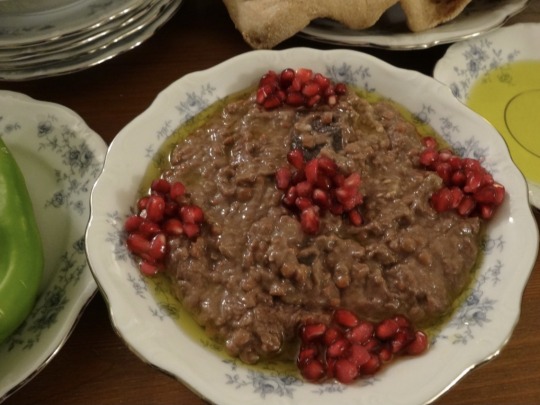
[ID: A purplish-grey stew topped with olive oil and garnished with piles of pomegranate seeds. Plates of green peppers, bitter olives, olive oil, taboon bread, green onions, radishes, and za'tar surround the dish. The second image is a close-up of the same stew. End ID]
رمانية / Rummāniyya (Palestinian pomegranate stew)
Rummaniyya (رُمَّانِيَّة; also transliterated "rumaniyya," "rummaniya," and "rummaniyeh") is a Palestinian stew or dip made from lentils, eggplant, and pomegranate seeds, flavored with nutty red tahina and a zesty, spicy دُقَّة (dugga) of dill seeds, garlic, and peppers. A طشة (ṭsha), or tempering, of olive oil and onion or garlic is sometimes added.
"Rummaniyya," roughly "pomegranate-y," comes from رُمَّان ("rummān") "pomegranate," plus the abstract noun suffix ـِيَّة ("iyya"); the dish is also known as حبّة رُمَّانَة ("ḥabbat rommāna"), or "pomegranate seeds." It is a seasonal dish that is made at the end of summer and the beginning of fall, when pomegranates are still green, unripe, and sour.
This stew is considered to be one of the most iconic, historic, and beloved of Palestinian dishes by people from Gaza, Yaffa, and Al-Ludd. Pomegranates—their seeds, their juice, and a thick syrup made from reducing the juice down—are integral to Palestinian cuisine and heritage, and images of them abound on ceramics and textiles. Pomegranates and their juice are sold from street carts and cafes in the West Bank and Gaza.
Today, tens of thousands of tons of pomegranates are grown and harvested by Israeli farmers on stolen Palestinian farmland; about half of the crop is exported, mainly to Europe. Meanwhile, Palestinians have a far easier time gaining permits to work on Israeli-owned farms than getting permission from the military to work land that is ostensibly theirs. These restrictions apply within several kilometers of Israel's claimed borders with Gaza and the West Bank, some of the most fertile land in the area; Palestinian farmers working in this zone risk being injured or killed by military fire.
Israel further restricts Palestinians' ability to work their farms and export crops by imposing tariffs, unexpectedly closing borders, shutting down and contaminating water supplies, spraying Palestinian crops with pesticides, bulldozing crops (including eggplant) when they are ready to be harvested, and bombing Palestinian farmland and generators. Though Palestinian goods have local markets, the sale of Palestinian crops to Israel was forbidden from 2007 to 2014 (when Israel accepted shipments of goods including tomato and eggplant).
Gazans have resisted these methods by disregarding orders to avoid the arable land near Israel's claimed borders, continuing to forage native plants, growing new spices and herbs for export, planting hydroponic rooftop gardens, crushing chalk and dried eggplants to produce calcium for plants, using fish excrement as fertilizer, creating water purification systems, and growing plants in saltwater. Resisting Israeli targeting of Palestinian food self-sufficiency has been necessary for practical and economic reasons, but also symbolizes the endurance of Palestinian culture, history, and identity.
Support Palestinian resistance by calling Elbit System's (Israel's primary weapons manufacturer) landlord; donating to Palestine Action's bail fund; and buying an e-Sim for distribution in Gaza.
Serves 6-8.
Ingredients:
For the stew:
1 medium eggplant (370g)
1 cup brown lentils (عدس اسود)
600g pomegranate seeds (to make 3 cups juice)
3 Tbsp all-purpose flour
1/4 cup red tahina
1/2 cup olive oil
Salt, to taste
Citric acid (ملح الليمون / حامِض ليمون) (optional)
Red tahina may be approximated with home cooking tools with the above-linked recipe; you may also toast white tahina in a skillet with a little olive oil, stirring often, until it becomes deeply golden brown.
For the دُقَّة (dugga / crushed condiment):
2 tsp cumin seeds, or ground cumin
1 1/2 Tbsp dill seeds ("locust eye" بذور الشبت / عين جرادة)
5 cloves garlic
1 green sweet pepper (فلفل بارد اخضر)
2 dried red chilis (فلفل شطة احمر)
People use red and green sweet and chili peppers in whatever combination they have on hand for this recipe; e.g. red and green chilis, just green chilis, just red chilis, or just green sweet peppers. Green sweet peppers and red chilis are the most common combination.
For the طشة (Tsha / tempering) (optional):
Olive oil
1 Tbsp minced garlic
Instructions:
1. Rinse and pick over lentils. In a large pot, simmer lentils, covered, in enough water to cover for about 8 minutes, or until half-tender.
2. Meanwhile, make the dugga by combining all ingredients in a mortar and pestle or food processor, and grinding until a coarse mixture forms.
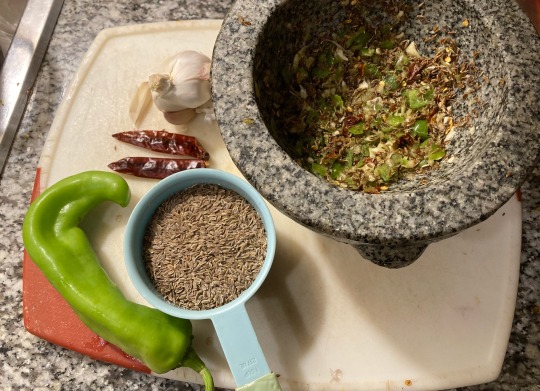
Dugga and components.
3. Cube eggplant. A medium-sized eggplant may be cut in half lengthwise (through the root), each half cut into thirds lengthwise, then cubed widthwise.
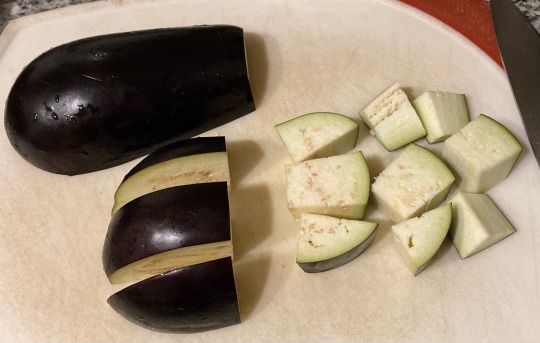
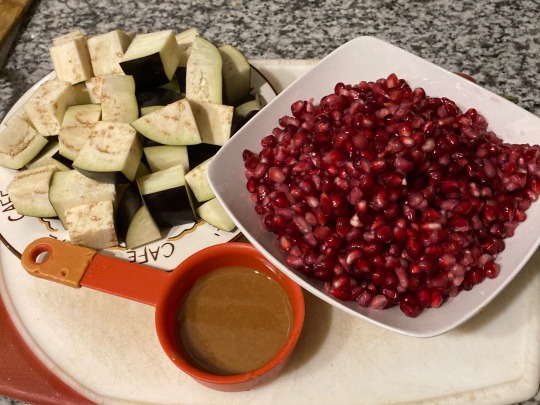
Cubed eggplant, red tahina, and pomegranate seeds.
4. Add eggplant to simmering water (there is no need to stir).
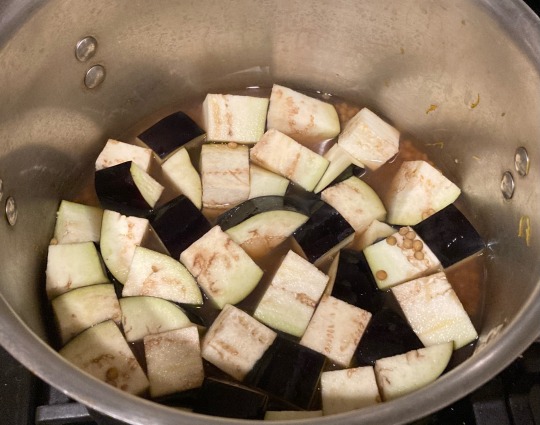
5. While the eggplant cooks, blend pomegranate seeds in a blender very thoroughly. Strain to remove any gritty residue. Whisk flour into pomegranate juice.
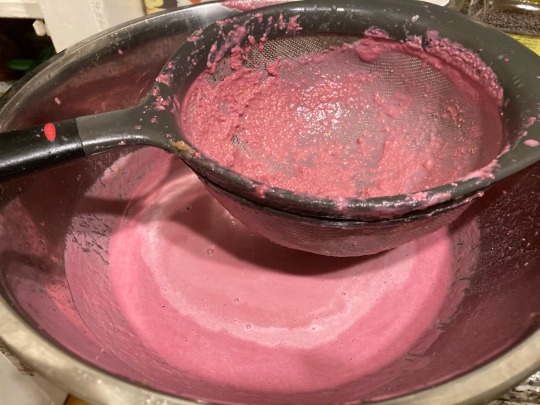
Pomegranate juice being strained.
6. Taste your pomegranate juice. If it is not sour, add a pinch of citric acid or a splash of lemon juice and stir.
7. Add dagga to the pot with the lentils and eggplant and stir. Continue to simmer until the eggplant is very tender and falling apart.
8. Add pomegranate juice, tahina, and olive oil to the pot, and simmer for another 5 minutes, or until stew is very thick and homogenous.
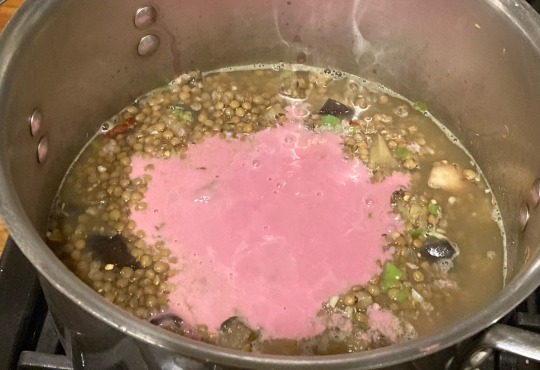
Bright pink pomegranate juice in stockpot.
9. (Optional) In a small skillet, heat a little olive oil on medium. Fry minced garlic, stirring constantly, until golden brown. Add into the pot and stir.
10. (Optional) Mash the stew with the bowl of a ladle or a bean masher to produce a more homogenous texture.
Serve rummaniyya hot or cold in individual serving bowls. It may be served as an appetizer, or as a main dish alongside flatbread, olives, and fresh vegetables such as radishes, green peppers, green onions, carrots, and romaine lettuce. It may be eaten with a spoon, or by using كماج (kmāj), a flatbread with an internal pocket, to scoop up each bite.
574 notes
·
View notes
Text

Hellenic Polytheism or Hellenismos is the traditional, polytheistic (multiple gods) religious belief system of Ancient Greece. Modern people who believe in pre-Christian and polytheistic belief systems often refer to themselves as pagans. Let’s look at some of the general practices of typical Hellenic worship.
Hellenic Polytheists use altars or shrines to worship specific Gods within the Greek Pantheon. For example, an altar for Apollo may contain an image or sculpture bust of the god, as well as a side table, called a trapezōmata, which holds offerings of incense and flowers or food and drink such as wine, honey, milk, or olive oil. Another tripod incense holder was called a Thymiateria.
Before engaging in a ceremony, the practitioner will employ purification methods with lustral water (ritually cleansed). They may recite hymns or prayers in honor of the god, using the Homeric hymns for example. The practitioner may use a divination practice to seek guidance or gain insight from a god through methods like casting lots, reading signs from nature, oracle prophecies, and dream interpretations. In their ceremonies, ancient Greeks would perform rites in respect to their Ta Patria, (ancestral homeland heritage), and they would take pride in their reverence with Hos Kallista, or the highest level of beauty.
Hellenic Polytheism follows annual calendar festivals commemorating Gods or famous mythological events such as the Panathenaia in Athens (commemorating Athena), the Anthesteria and City Dionysia; (festivals celebrating Dionysus) The Olympics (a physical competition in honor of Zeus) and the Thargelia, (dedicated to Apollo and Artemis), and the Thesmophoria, (a festival exclusive to women in honor of Demeter), among many others.
Want to own my Illustrated Greek myth book jam packed with over 130 illustrations like this? Support my kickstarter for my book "lockett Illustrated: Greek Gods and Heroes" coming in October.You can also sign up for my free email newsletter. please check my LINKTREE:
#pagan#hellenism#greek mythology#tagamemnon#mythology tag#percyjackson#dark academia#greek#greekmyths#classical literature#percy jackon and the olympians#pjo#homer#iliad#classics#mythologyart#art#artists on tumblr#odyssey#literature#ancientworld#ancienthistory#ancient civilizations#ancientgreece#olympians#greekgods#zeus#hesiod
580 notes
·
View notes
Text
Explain the basic: Herbs,Oils and Crystals.

Disclaimer: All the things in this post are based on research and personal experience. As much as I could be a teacher, I suggest you find many resources for knowledge to develop your own experiences.
I will do another post about each of those three things to let you have some guide lines that you can follow, especially for the crystals because some have different ways to be clensed, and if you clense it with the wrong thing, it could damage the crystal (nothing will happen if you break or damage a crystal, but we have to take care of our things).

In witchcraft, the selection and use of herbs, oils, and crystals often depend on an individual's belief system, intuition, and the specific intentions or goals of their practice. Herbs, oils, and crystals are tools we can use in any type of ritual or spell.
Herbs:
Magical Properties: Different herbs are believed to possess unique magical properties. For instance, rosemary might be associated with protection, lavender with relaxation and purification, and sage with cleansing negative energies.
Ritual Use: Herbs can be used in rituals, spells, and potions. They may be burned as incense, infused in oils or teas, or sprinkled during ceremonies to invoke specific energies or intentions.
Healing: Herbalism is often a part of witchcraft, where herbs are used for medicinal purposes. Herbal remedies may be prepared for physical healing, emotional balance, or spiritual well-being.
Oils: Disclaimer: Make sure you research the oils you buy/use because some oils can damage or hurt your skin in a really bad way. as well as some aromatherapy oils that can hurt your pet (if you have one).
Anointing: Oils are commonly used for anointing tools, candles, or individuals during rituals. They are believed to imbue objects or people with specific energies or intentions.
Aromatherapy: Essential oils are used for their scents, which are thought to influence moods, emotions, and energies. Different scents are associated with various properties, such as calming, energizing, or purifying.
Crystals:
Energies and Properties: Crystals are believed to have their own unique energies and properties. For example, amethyst might be associated with spiritual growth and intuition, while quartz might be seen as a general-purpose amplifier of energies.
Charging and Cleansing: Crystals are often charged with specific intentions and cleansed of any negative energies. They can be placed under moonlight or sunlight, smudged with sage, or buried in earth to reset their energies.
Meditation and Ritual: Crystals are frequently used in meditation practices or incorporated into rituals. They may be held, worn as jewelry, or placed in specific patterns to enhance spiritual work.

As always, I will love to hear your thoughts! and if you have any questions, I will be more than happy to answer them! If you liked it, leave a comment or reblog (that is always appreciated!). and have a wonderful day or night!
#journal#manifestation#manifestation method#manifesting#shifting methods#manifesation#loa methods#spiritual development#explain the method#explained#witchcraft#witchblr#witches#witchcore#witch#witches of tumblr#teaching witchcraft#witch community#witch aesthetic#witch tips#healing crystals#witchcraft community#witchcraft 101#magick#pagan witch#witchcraft books#witchcraft smp#witchcraft aesthetic#grimoire#spirituality
158 notes
·
View notes
Text
Everything You Need to Know About Herbs: Rosemary
Rosemary (Rosmarinus officinalis, Salvia rosmarinus)
*Poisonous *Medical *Kitchen *Masculine

Folk names: Compass weed, Dew of the Sea, Elf Leaf, Guardrobe, Incensier, Libanotis, Polar Plant, Seas Dew
Planet: Sun
Element: Fire, Air
Abilities: Protection, Love, Lust, Mental Power, Exorcism, Purification, Healing, Sleep, Youth
Why Poisonous?: Their oil content. Large quantities of rosemary leaves can cause vomiting, spasms, coma and in some cases, pulmonary edema (fluid in the lungs). Rosemary can cause miscarriages so it is not recommended for expecting mothers. It is also not recommended for those with high blood pressure, ulcers, Crohn’s disease or ulcerative colitis.
Do not consume rosemary oil
Characteristics: With its aromatic, needlelike leaves, the rosemary plant grows in a bush and can be quite large in the right growing conditions. Can grow two lipped, purplish-blue and white flowers.
History: Was first referenced on a stone tablet that dates back to 5000 BCE. Is native to the Mediterranean region. It was considered sacred by the Spanish due to its association with the Virgin Mary. In France, it is referred to as incensier due to its popular usage as an incense.
Growing Rosemary:
Easy to grow?: Yes.
Rating: Beginner Friendly
Seeds Accessible: Yes
How to Plant Rosemary
Video Guide
Where to Find Seeds
Magical Usage:
Stimulates memory and thought processes
If burned, adds an energy of protection and purification to a space
Sprinkling its leaves onto graves will cause the undead to be at peace
Carried in an Herbal Amulet will give one confidence and courage
Placing the leaves under your pillow will ensure good sleep and banish nightmares
Can be used in love and lust incense spells as well as healing poppets
Used to be included in bridal flowers so that the couple will stay true to their vows
The smell is supposedly very offensive to evil spirits
Smelling rosemary every day can help preserve one’s youth
Medical Usage
In oil form, can be used to relieve rashes and blemishes on the skin
Can help relieve muscle pain, improve memory, boost the immune system, and promote hair growth
In balm form, can repel insects
Sources
#witchcraft#green witch#witch community#witchblr#herbalist#medicinal herbs#plants and herbs#paganblr#occulltism#nature#alchemy#magick#culinary herbs#rosemary#seeds#gardening#witch garden#plantblr#plants#botany#witch tips#witches of tumblr#witchcraft resources#witch blog#beginner witch#kitchen witch#kitchen witchcraft#herbs#herbalism#baby witch
283 notes
·
View notes
Text
There is No Karma In Cunning
Modern Witchcraft and magical systems that do not come from Eastern traditions and religions should not be concerning themselves with Karma. Most often when Karma is imported into witchcraft and western magic it is completely watered down from its original source. The white washed understanding of karma is appropriative, unoriginal, and inaccurately portrays Karma. I dont think it's appropriate for me to still be finding witches making a “good karma oil” and then go on to describe a potent purification and protective oil. Good fortune oil, luck oil, road opener oil etc all are fine and fit into the philosophies of many western traditions. Let us please move away from Karma in western Witchery, Cunning and magic.
#witchcraft#tradionalwitchcraft#moderntradionalwitchcraft#ecstaticwitchcraft#folkloricwitchcraft#folkmagic#sorcery#animism#Paganism#eastern thought#Buddhism#Hinduism#eastern esotericism#eastern occultism
29 notes
·
View notes
Text
How to read an oil can
OEMs, oil marketers, additive companies, and testing laboratories work together to establish oil performance requirements, test methods, and limits for the various classifications and testing processes.

The system includes a formal licensing agreement executed by lubricant suppliers with API. Through this program, API has standardized the labeling of engine oils by adopting the donut logo (Figure 1). The logo was designed to be placed in a prominent position on a variety of lubricant containers.
API – American Petroleum Institute: The American Petroleum Institute (API) administers the licensing and certification of engine oils through a system that meets the warranty, maintenance, and lubrication requirements of original equipment manufacturers.
SAE – Society of Automotive Engineers: SAE is an organisation that certifies and standardised working elements for automotive, aerospace, and commercial vehicles.
SAE 10W-30: The SAE has established a numerical code system for grading oils according to their viscosity characteristics. Because of the viscosity of oil changes with temperature, multigrade oils were developed to provide protection across a range of temperatures.
SAE 10W30 is an oil that has SAE 10W viscosity (thickness) at low temperatures, and SAE 30 viscosity at high temperatures. The W stands for 'Winter'. Note that these viscosities are relative and standardised numbers and no absolutes, the oil doesn't get thicker when it's hot, it gets thinner.
Category Classification on Oil Cans:
1 - 5W: Here, 5 describes the viscosity of the oil at low temperatures. W stands for ‘Winter’. The lower the number, the thinner the oil and the better the oil’s cold temperature performance. 2- 30: It describes how thick the oil is at the normal operating temperature. Multigrade oils such as SAE 5W-30 and 10W-40 are widely used because, under all but extremely hot or cold conditions, they are thin enough to flow at low temperatures and thick enough to perform satisfactorily at high temperatures. In other words, the choice of viscosity would be different depending on the climate conditions of the operational site.
Also read: https://www.linkedin.com/pulse/storage-management-oil-products-its-importance-agrawal-mlt-1-/
We at Minimac study your maintenance needs and provide the best solution. We believe in Discern, Design & Deliver. Call +91 7030901266 for Mechanical Maintenance & Oil Check.
#frf#oil flushing#minimac systems#power#minimac#oil & gas#hydraulic oil#lube oil filter#contamination#hydraulic oil filter#oil purification machine#oil purification systems#oil purification system#oil contamination#oil filters#oil testing#oil industry#oil and gas#frf condition systems#condition monitioring#oil condition monitoring#coalscer#separator#transformation oil purification#diesel oil purification#chemical cleaning#hydraulic oil filter#hyraulic oil cleaning#lube oil flushing#lube oil
1 note
·
View note
Text
Enhance Your Operations with PowerFlow XLP Series Oil Purification Systems

PowerFlow XLP Series lube and hydraulic oil purifiers offer exceptional value through innovative design. These oil purifiers combine advanced dehydration technology with high-capacity, absolute-rated filtration to efficiently remove water, particulates, and gases from lubrication and hydraulic oils. Utilizing a packed bed mass transfer tower under moderate vacuum and temperature, the XLP Series removes 100% of free and emulsified water and gases, and up to 90% of dissolved water and gases, without the need for high heat, deep vacuum, or submicron filtration. This ensures that the oil's quality is maintained, extending its lifespan and efficiency.
Key features of the XLP Series include PLC automation for extended continuous run times, a variable-speed discharge pump, and high-capacity filter elements. The innovative dry claw vacuum pump minimizes maintenance requirements, making the XLP Series the best value in the industry. Available in models for 5, 10, 20, and 50 gpm oil flow rates, these purifiers are designed to meet various operational needs.
Optimize your oil purification process with the PowerFlow XLP Series, and experience unparalleled efficiency and reliability.
0 notes
Text
Best Oil Purifier Machine – Advanced Industrial Oil Purification System
Industrial machinery relies heavily on clean and high-quality oil for smooth and efficient operation. However, contaminants like dirt, metal particles, sludge, and water degrade oil quality over time, leading to increased maintenance costs and reduced equipment lifespan. Investing in an oil purifier machine is a cost-effective solution that ensures oil purity, enhances machinery efficiency, and prevents system failures.
What Is an Oil Purifier Machine?
An oil purifier machine is an advanced filtration system designed to remove solid and liquid contaminants from industrial oil. These machines use various purification technologies, such as vacuum dehydration, centrifuge separation, and mechanical filtration, to enhance oil quality and performance.
By eliminating moisture, particulate matter, and oxidation by-products, an oil purification system helps industries maintain optimal machinery operation, reducing wear and tear while improving overall productivity.
Why Is Oil Purification Essential?
Extends Oil Life – Regular purification prevents oil degradation, reducing the need for frequent oil replacements.
Improves Equipment Performance – Clean oil ensures smooth machinery operation and minimizes downtime.
Reduces Maintenance Costs – Proper oil purification lowers the risk of equipment failure and expensive repairs.
Enhances Environmental Sustainability – Reusing and purifying oil minimizes industrial waste and promotes sustainability.
0 notes
Text
An arbitrary element system
(Inspired by @discoursedrome writing this, original post seems to have been deleted so I'm linking to a reblog; also apologies to Samin Nostrat)
SALT: Associated with protection, preservation, and constancy. Marble statues, ramparts, cats, trees, and the priestly/noble classes are all considered strongly salt-aligned. More abstractly, astronomy, architecture and to a lesser extent currency all fall under its purview as well. Salt-aligned characters run the gamut from honorable knights to peaceful gardeners to bronze age god-kings. Its season is winter.
Magic of salt can create create impassable wards, render promises unbreakable, or unleash curses of petrification. It can never be used to separate or destroy, and its more powerful effects often require elaborate sigils to be drawn. Those skilled in salt magic have their lifespan greatly lengthened, and may live for many centuries, but find their minds growing ever more rigid and inflexible.
FAT: Associated with creation, growth, restoration, and foresight (as fat is, by its very nature, a store to be used in the future). Fat is associated with predators (especially birds), craftsmen, and the merchant class, as well as healers, teachers, musicians, and writers. Its season is summer.
Fat magic can grow a house from a splinter of wood, grant its wielder another man's face, twist entrails into the shape of the future, and even revive the dead for a time. However, it is powerless to affect anything that was never alive. Its effects become more potent the longer they are maintained, but doing so drains ever more of the wielder's reserves: many a mage has tried to push past their limits and combusted in flames on the spot.
ACID: Associated with destruction, upheaval, and scarcity. However, acid is also the element of forgiveness, freedom, persistence, and honesty, and governs unlikely alliances and fire-forged bonds. Scavengers and vermin are aligned with acid, as is anyone who falls outside of the conventional social hierarchy: beggars, criminals, outcasts, and ascetics. Its season is autumn.
Acid magic creates can summon hailstorms, spew gouts of burning oil, conjure frightful phantasms or inflict wracking pains. Magic that undoes charms and curses also falls under the element of acid, as does anything that facilitates travel between the planes or calls their denizens here. Acid magic demands components of great rarity; gemstones, powdered dragonscale, the bones of saints. Those who cannot pay a spell's price must suffer its scarring backlash instead, and most senior acid mages are hideous to look upon.
HEAT: Associated with transubstantiation, purification, ambition, and toil. Farmers and unskilled laborers are heat-aligned, but so are smiths, herbalists, glassblowers, and of course alchemists. Herbivorous animals are a manifestation of this element, as are the shoots and grasses they feed upon. Its season is spring.
Heat magic often manipulates energies. Telekinetic effects are heat magic, as are blasts of radiance or bursts of heat. A shield of heat magic may dissipate powerful blows as harmless light, or even reflect the force back onto the attacker. Obviously, heat magic also includes all those magics that turn a substance into another, from turning lead into gold to rusting iron or calling water from rock. Its wielders are forced to specialize ever more: the more powerful an effect one wishes to conjure, the more facets of this magic become permanently unavailable. Thus, the masters of heat magic are those that have found many creative applications for a single spell effect.
361 notes
·
View notes
Text
Herb Spotlight: Thyme

History & Origins
Thyme (Thymus vulgaris) is a perennial herb that has been cherished for its culinary, medicinal, and spiritual properties for thousands of years. Originating from the Mediterranean region, thyme was used by the ancient Egyptians for embalming, while the Greeks and Romans valued it for its antiseptic properties and burned it as incense in temples to purify spaces.
The name "thyme" is believed to come from the Greek word "thymos," meaning courage or strength. Roman soldiers would bathe in thyme-infused water to gain bravery before battles. In the Middle Ages, it was also tucked under pillows to ward off nightmares and given to knights and warriors as a symbol of courage.
Where & How to Grow Thyme
Thyme is a resilient, sun-loving herb that thrives in well-drained soil and can be grown both indoors and outdoors.
Climate: Thyme prefers warm, sunny climates with at least 6 hours of sunlight daily. It's drought-tolerant and does well in zones 5-9.
Soil: Grows best in well-drained, sandy soil with a slightly alkaline pH. Avoid overwatering, as thyme doesn't tolerate soggy soil.
Growing from seeds: Start thyme seeds indoors 6-8 weeks before the last frost, or plant cuttings directly in the garden in spring or early summer. Thyme can also be propagated easily by root division.
Spacing: Plant thyme about 12 inches apart in a sunny location. It can also be grown in pots or as a ground cover, as it only grows to about 6-12 inches tall.
Harvesting: Harvest thyme when the plants are dry, preferably in the morning, by cutting sprigs just before the flowers bloom. The leaves can be used fresh or dried for later use.
Health Benefits
Thyme offers numerous medicinal benefits when used orally or topically.
Oral Uses:
Respiratory support: Thyme is a natural expectorant, helping to clear mucus and ease symptoms of coughs, colds, bronchitis, and sore throats. Drinking thyme tea or using thyme honey is particularly effective.
Antimicrobial properties: Thyme contains thymol, an essential oil with antibacterial, antifungal, and antiviral properties. It helps fight infections and boost the immune system.
Digestive aid: Thyme is excellent for relieving indigestion, bloating, and gas. It can also help regulate gut bacteria and support digestive health.
Antioxidant support: Rich in vitamin C and other antioxidants, thyme helps reduce oxidative stress, supporting overall wellness and aging.
Topical Uses:
Skin health: Thyme can be used as a natural antiseptic for treating wounds, cuts, and infections. It also helps soothe skin conditions such as acne, eczema, and fungal infections due to its antimicrobial properties.
Anti-inflammatory: When applied topically, thyme can reduce inflammation and swelling, making it useful for treating skin irritations or minor burns.
Hair growth: Thyme oil is often used in natural hair care products for stimulating hair growth and treating dandruff due to its antimicrobial properties.
Magical Properties
Thyme has long been associated with purification, protection, and courage in magical practices.
Purification: Thyme is used in cleansing rituals, either burned as incense or added to baths to cleanse one's aura or energy field. It is believed to purify spaces, removing negative energies or spirits.
Protection: Thyme is often carried or placed in doorways for protection from harm or ill intentions. It can also be worn as a charm to ward off negative energies and bad dreams.
Courage & Strength: Thyme is associated with bravery. In magical workings, it’s used to summon strength and courage, especially when facing difficult situations or challenges. It can be carried as a talisman or burned before spell work to empower the caster.
Healing: Thyme is often used in spells related to healing, vitality, and renewal. It's added to healing potions, incense, and sachets to promote physical and emotional recovery.
Love & Attraction: In love magic, thyme is believed to attract love and affection. It’s often included in love sachets, charms, or baths to draw positive relationships and strengthen existing ones.
Using Thyme in Your Practice
Thyme tea: Brewed as tea, thyme can be sipped to promote healing, clear the mind, and fortify the spirit before rituals.
Burning thyme: Burn dried thyme as an offering to deities, or use the smoke to cleanse and purify spaces, objects, or yourself.
Thyme oil: Dilute thyme essential oil in a carrier oil and use it in healing rituals or anointing candles to promote health and protection.
Thyme is a versatile herb with deep roots in history, known for its medicinal, culinary, and magical uses. Whether you're growing it in your garden or using it in your magical practice, thyme offers powerful healing, protective, and purifying qualities that make it a must-have in any herbalist's or witch’s collection.
#herb spotlight#herbs#plant magic#herbalism#plant medicine#thyme#witch#witchy#witchcraft#kitchen witch#green witch#witchblr
31 notes
·
View notes